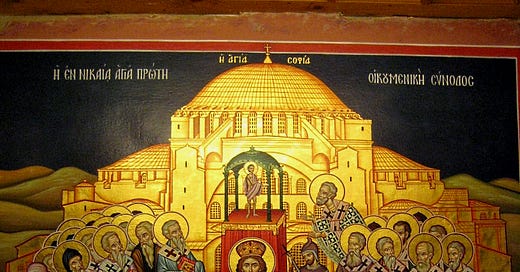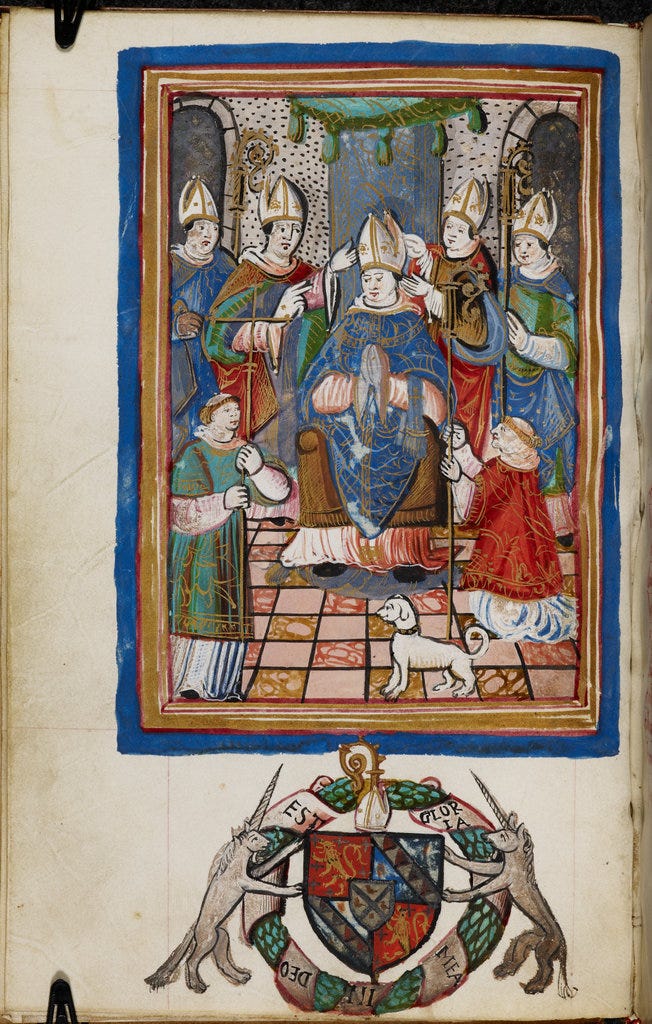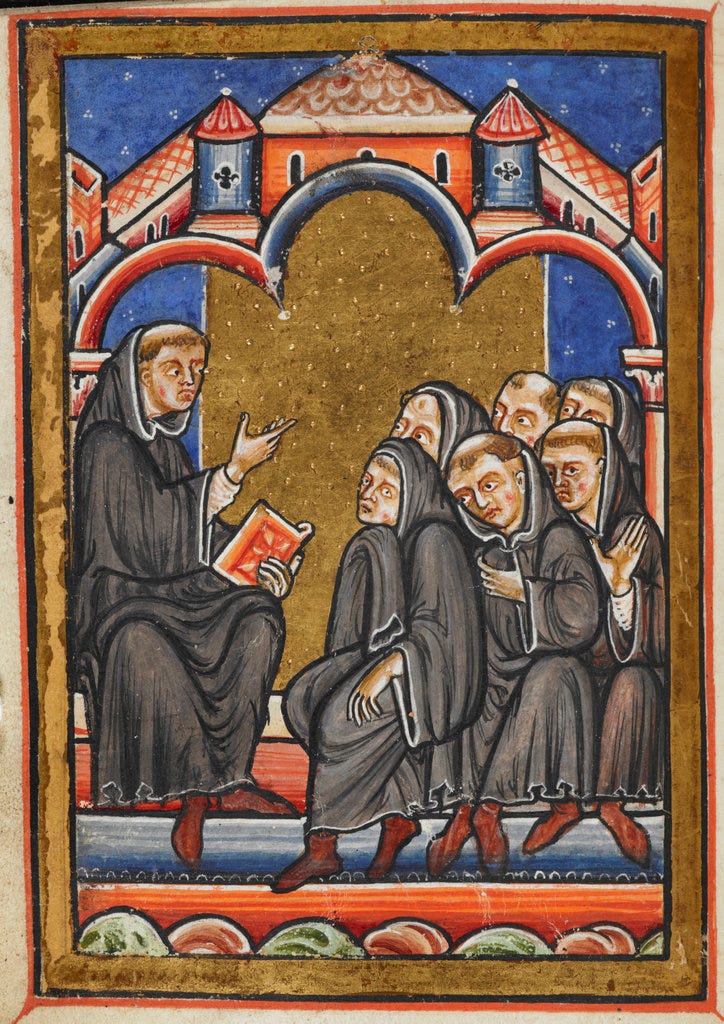Chapter 10 (Part 6): The Medieval Christian Church as Sacred and Secular
Continental Europe transformed with the fusion of Christianity with kingship. The Christian church possessed the structure and political influence to take over once the Western Roman Empire declined.
If you are new here, we are reading David Graeber’s Debt: The First 5,000 Years. Catch up and join us on Thursdays in 2024. My first slow read here on Substack in 2023 was David Graeber’s The Dawn of Everything. These two books showcase his thesis on the development of humanity by looking at how debt evolved and how people organised themselves and their world. Unique among his peers, Graeber still asks the big questions in anthropology.
Dear Reader,
Happy New Year to everyone! I wish everyone consistency in achieving their daily and weekly goals until the end of the year. This is my own 2025 resolution.
Curiousity trumps the calendar restriction so, unlike other clubs, we are still completing our book here. It’s never too late to start my two featured books to coincide with January.
I am trying not to feel guilty for not planning my writing (for good and bad) and simply follow emergent ideas. I look forward to concluding with this book by end of February (fingers crossed).
Welcome and let’s continue consistently writing, reading, and thinking in 2025.
Melanie
Christendom as religion and government
Before we tackle Graeber’s interrelated themes, namely:
the fraught relationship between Jews and Christians and the difficulties of defining credit and usurious relationships
the rise of religious mercantile groups and credit arrangements made by the Templar Knights
the enforcement of order and creation of new markets via the travelling knights and the romanticising of the merchant adventurer
the emergence of the corporation via the European monasteries
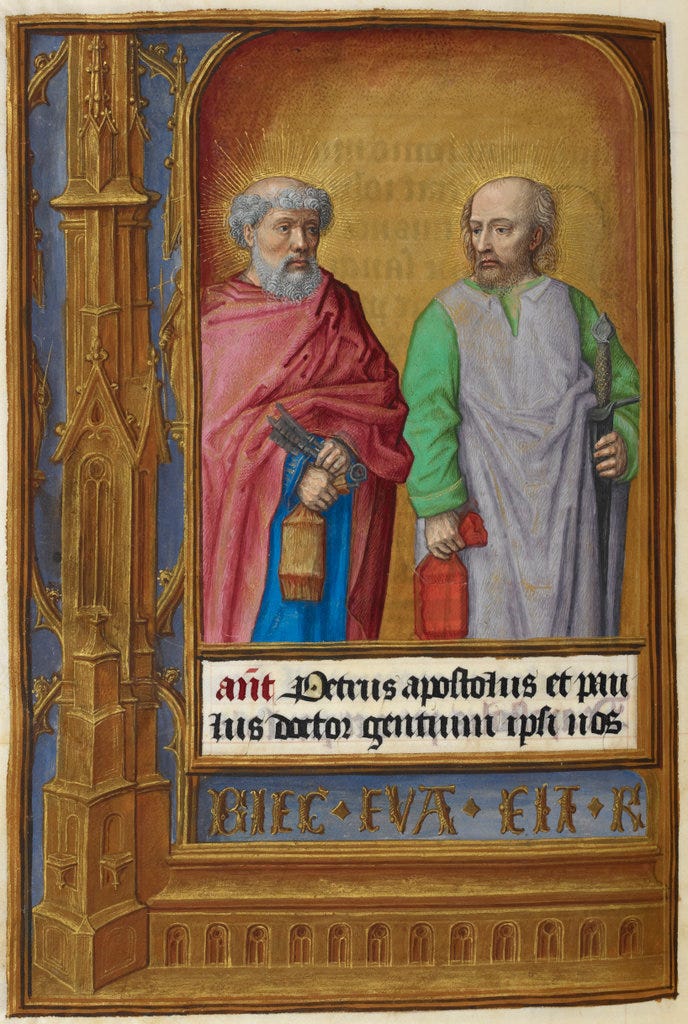
We need to need to ask:
how did medieval Europe came to be so inextricably linked with Christianity and Christian values
how did the church emerge to become both religious and secular rulers with land and kingdoms
By understanding how this happened can we begin to understand the relationship of medieval Europe with Christian churches and their financial power.
The Europeanisation of Early Christendom
To understand why medieval Europe is synonymous with Christianity, I first turn to how it came to continental Europe.
Christianity emerged after the cruxifiction and death of Jesus of Nazareth around AD 33 (dates vary if you calculate his birth a few years after the death of King Herod (37- 04 BC), Rome’s appointed ruler in Judea). The church as an organisation began with Jesus’ apostles led by St. Peter (died AD 64 - 68), who would be later acknowledged as the head of the Church, and Paul of Tarsus, better known as St. Paul (AD 06 - 64/65).
Early Christianity was built from a schism with Judaism. Peter wanted a church or the continuity of practice rooted within Judaism. This was the pathway of the early Christians whose beliefs relied on the Old Testament. However, this was untenable in the long run. It was in contradiction to Jesus’ Gospel of a universal message of redemption that reaches out to the Gentiles (a term to refer to non-Jews). St. Paul’s christianising mission westward to Rome effectively tied Christianity and the Church with Europe according to G.R. Evans.
Paul’s mission: to convert the Gentiles. The history of his mission is the history of Christian Europe. This would take him to the large cities of Constantinopole, Athens, and to Rome but also to populated urban areas of Antioch, Philippi, and Corinth. It was from these small and large urban areas that Paul wrote his letters and epistles that would constitute almost half of the twenty seven chapters in the New Testament. The spread and establishment of Christianity in Europe is enmeshed with the Hellenistic or Greek culture found in those cities. Paul wrote his letters in Greek.

Fusion of the sacred and secular
The early church prior to AD 300 was struggling against several factors in its early institutionalisation period:
periodic persecution or skirmishes from the Jewish establishment and the polytheistic Roman government
multiple interpretations of the faith within the community
I am highlighting two events that merged the secular and religious power that paved the way for a Christian-based European culture.
Conversion of Constantine: political move?
Christianity was an illegal religion and suffered heigthened prosecutions under Diocletian in AD 303. However, it was the Edict of Milan in AD 313 that created the religious tolerance policy for all religions especially Christianity across the Roman Empire.
When I, Constantine Augustus, as well as I Licinius Augustus fortunately met near Mediolanum (Milan), and were considering everything that pertained to the public welfare and security, we thought -, among other things which we saw would be for the good of many, those regulations pertaining to the reverence of the Divinity ought certainly to be made first, so that we might grant to the Christians and others full authority to observe that religion which each preferred; whence any Divinity whatsoever in the seat of the heavens may be propitious and kindly disposed to us and all who are placed under our rule And thus by this wholesome counsel and most upright provision we thought to arrange that no one whatsoever should be denied the opportunity to give his heart to the observance of the Christian religion, of that religion which he should think best for himself, so that the Supreme Deity, to whose worship we freely yield our hearts) may show in all things His usual favor and benevolence.
Therefore, your Worship should know that it has pleased us to remove all conditions whatsoever, which were in the rescripts formerly given to you officially, concerning the Christians and now any one of these who wishes to observe Christian religion may do so freely and openly, without molestation. We thought it fit to commend these things most fully to your care that you may know that we have given to those Christians free and unrestricted opportunity of religious worship. When you see that this has been granted to them by us, your Worship will know that we have also conceded to other religions the right of open and free observance of their worship for the sake of the peace of our times, that each one may have the free opportunity to worship as he pleases ; this regulation is made we that we may not seem to detract from any dignity or any religion.
from Lactantius, De Mort. Pers., ch. 48. opera, ed. 0. F. Fritzsche, II, p 288 sq. (Bibl Patr. Ecc. Lat. XI)
Constantine himself was a Christian convert, perhaps for political reasons, to garner all advantages against his co-emperors in the Roman Empire. He was in the process of eliminating his rival, co-emperor Maxentius when…
According to the historian Eusebius of Ceasarea, Constantine had a dream or vision. Eusebius says that Constantine told him the story himself, setting his vision on a march rather than at the camp before the Milvian Bridge. He saw a bright cross in the sky above the sun with an inscription, ‘in this sign you shall conquer’ (in hoc signo vinces). Eusebius says that God promised him victory if the shields of his soldiers were painted with the symbol of the Cross (staurogram).
G.R. Evans, p. 26
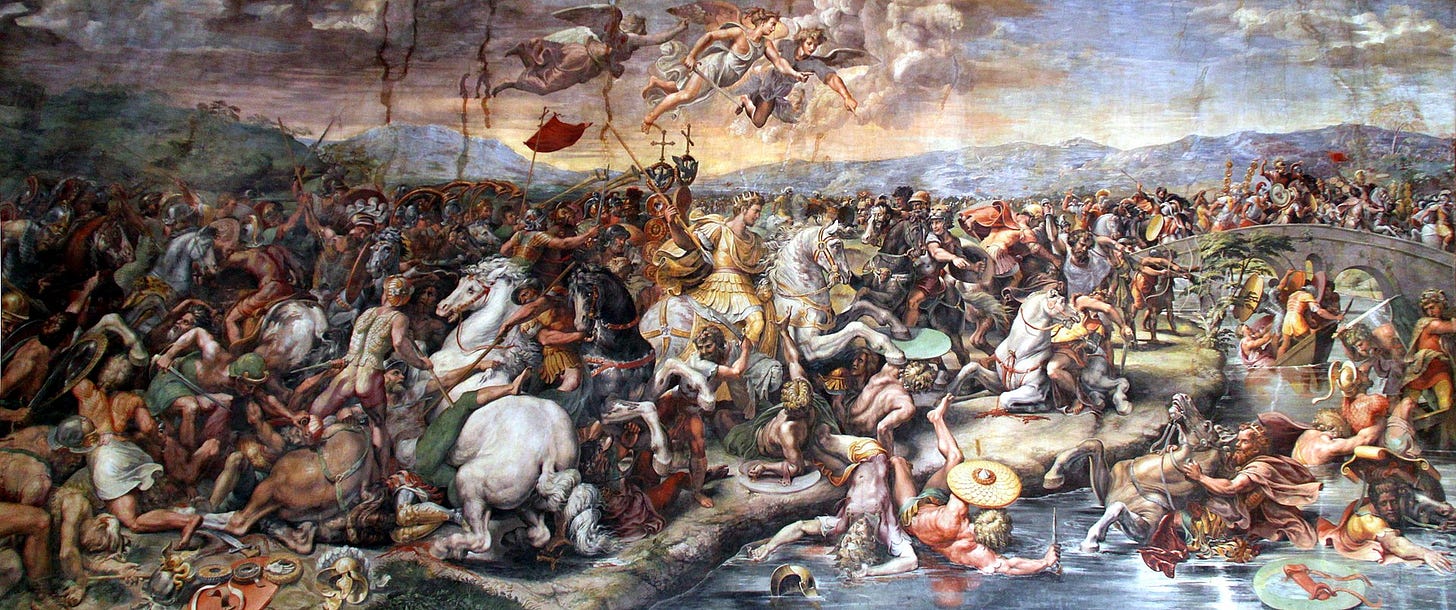
Indeed, Constantine vanquished his enemies and established Constantinopole as the capital of his Byzantine Empire. No doubt, his mother, later St. Helena, was highly influential in his life. She was a devout Christian believer long before his public conversion. With this, Constantine became a potent symbol unifying the religious and secular power of a Christian kingship.
The First Council of Nicaea: cementing Constantine’s influence
With the edict of Milan, Constantine restored seized clergy property, granted tax exemptions, and allowed Christians to hold positions in the government. He was also instrumental in facilitating the first Council of Nicaea in Northwestern Anatolia in AD 325. The bishops from across the realm, said to number anywhere between 1200 - 1900 gathered under the sponsorship of the imperial coffers.
Constantine instigated, presided, and hosted the council’s debate on a central question: the humanity and divinity of Jesus Christ. It was a showdown against one large branch of Christianity called, Arianism led by Arius (AD 250/256 - 336), a prysbeter (a minister) of the church in Alexandria. In a dispute against his bishop, Arius argued that if the Son of God (Jesus) was man then he has a distinct reality from the God the Father and therefore subordinate to Him. This was contrary to the dominant Trinitarianism that argued for the singular substance of God the Father, God the Son, and The Holy Spirit. Arius’ beliefs were considered heretic and he was eventually exiled to Illyricum, now the Balkan region.

The Church began demonstrating its strength by streamlining beliefs and ousting critics. It gained legitimacy through its partnership with the Roman emperor, In turn, Constantine, whether it is an outcome of his mother’s influence, his vision in battle against a co-emperor Maxentius, or political expediency, or all of the above, aligned with the growing influence of the Church. Thus, he transformed the trajectory of secular imperial power by linking it with Christianity. This defined the nature of governance in the succeeding kingdoms of the former Roman Empire.
The outcome of the first council of Nicaea is enshrined in the Nicene Creed recited every Sunday as part of the Roman Catholic faith.
Christian church governance
By the time the last Roman emperor was removed by barbarians in AD 476, the church communities were in place to provide order and structure in a social vacuum. This was developed on two levels:
1. The urban church
You can think of the early evolution of the Christian spatial and governance structure as concentric circles of managerial control and influence. Prior to an actual building, communities gathered to practice the Last Supper and sacraments such as baptism. This is effectively a ‘church.’ However, since Christianity spread, a system of governance had to be made to systematise and manage the groups. The group of churches become part of a ‘diocese’ or ecclesiastical district managed by a ‘vicar’ or priest. A bishop or archbishop oversees severel diocesean districts or a province. These area groupings may not necessarily coincide with the Roman prefect division but more often coincide with urban centres.
Several of the large and important cities during that period have the titular designation of the bishopry: Alexandria, Antioch, Constantinopole and Jerusalem in the Byzantine Empire and Rome in the West. These districts are self-contained and self-managed.
It is important to highlight the urban nature of the early church because the term pagan or paganus in Latin came to acquire a double meaning:
it refers to non-Christian adherents and delineates and strengthens the Christian identity
it also refers to people from the rural and countryside that practiced other beliefs
St. Paul’s missions largely concentrated in urban areas.
The monastery
Another form of organisation that emerged was the monastery. It followed the practices of separation and contemplation that originated from the East and the Levant. The earliest monasteries appeared after AD 350 in France. The motivation is similar to the Buddhists’ use of caves or the roaming in the desert following Jesus’ own communion with the higher power. The separation from everyday life is replicated in the architectural form and spatial arrangement of a monastery that supports an individual and communal monastic life.
The purpose of the monastic life is to sharpen and adhere to the teachings and practices of Christianity. At that time, anyone may join a monastery. This led to disorder and thus, an abbot governed the community. The relationship between an abbot with a bishop or the governor of the city is unclear and is in flux given that the former two positions are autonomous and influential.
The strict rules that we know of monastic life came from St. Benedict who laid out the ‘pray and order’ ora et labora structure. These prescriptions are laid out in the Rule of Benedict that govern how the days and calendar years are organised, how to pray, work, and interact.
Politically and socially, the monastery has been used to sequester competing aristocratic heirs effectively making it a prison. Aristocratic endowments also enter the monastery’s coffers.
The Christian church has the advantage offered by both a pan-regional and micro-level structure of organisation that makes it suitable as a replacement when the Western Roman Empire dissolved.
Round-Up
Christianity and Hellenistic (Greek-based) culture in continental Europe came to be entertwined thanks to the mission of St. Paul (Paul of Tarsus) who spread the Gospel from Jerusalem to Constantinopole, the Balkans and to Rome.
The merging of the religion with secular kingship happened gradually. However, two notable events cemented this dual role:
the conversion of Constantine as the first Roman Christian emperor in AD 312 during the Battle of Milvian Bridge against co-emperor Maxentius
Constantine’s convening of the first ecumenical council of bishops in Nicaea in AD 325 to debate and streamline the belief structure of the mortality and divinity of Jesus Christ
These initiatives not only legitimised church leadership and rule but also aligned secular kingship to the dominant religion. Both acquired access and prestige of kingship in heaven and on earth. The church garnered power to define heretic beliefs, expel critics and non-believers, and exercise secular power as we shall see in the late medieval period.
Resources:
Evans, G.R. 2017. A Short History of Medieval Christianity. Bloomsbury Press: London.
Fouracre, Paul (ed.) 2005. The New Cambridge Medieval History Volume 1 c.500 - c.700. Cambridge University Press, Cambridge
Mattingly, W.J.B. The Medieval World podcast
McManners, John (ed.) 1993. The Oxford History of Christianity. Oxford University Press, Oxford
Young, Richard Kim (ed.) 2021. The Cambridge Companion to the Council of Nicaea. Cambridge University Press: Cambridge.
Re-read the previous post:
Chapter 10 (Part 5): Financial Freedom in Medieval Islam
The Abbasid Caliphate (AD 750 - 1258) has a two-tiered financial economy. The military machine tied the government to land taxation while the merchants developed credit arrangements based on trust.


